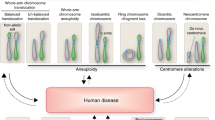Summary
Stable dicentric chromosomes behave as monocentrics because one of the centromeres is inactive. The cause of centromere inactivation is unknown; changes in centromere chromatin conformation and loss of centromeric DNA elements have been proposed as possible mechanisms. We studied the phenomenon of inactivation in two Y centromeres, having as a control genetically identical active Y centromeres. The two cases have the following karyotypes: 45,X/46,X,i(Y)(q12) and 46,XY/ 47,XY,+t(X;Y)(p22.3;p11.3). The analysis of the behaviour of the active and inactive Y chromosome centromeres after Da-Dapi staining, CREST immunofluorescence, and in situ hybridization with centromeric probes leads us to conclude that, in the case of the isochromosome, a true deletion of centromeric chromatin is responsible for its stability, whereas in the second case, stability of the dicentric (X;Y) is the result of centromere chromatin modification.
Similar content being viewed by others
References
Alexaindre C, Miller DA, Mitchell AR, Warburton DA, Gersen SL, Disteche L, Miller OJ (1987) p82H identifies sequences at every human centromere. Hum Genet 77:46–50
Daniel A (1979) Single Cd band in dicentric translocations with one suppressed centromere. Hum Genet 48:85–92
Earnshaw WC, Migeon BR (1985) Three related centromere proteins are absent from the inactive centromere of a stable isodicentric chromosome. Chromosoma 92:290–296
Earnshaw WC, Rothfield NF (1985) Identification of a family of human centromere proteins using autoimmune sera from patients with sclerodermia. Chromosoma 91:313–321
Earnshaw WC, Bordwell BJ, Marino C, Rothfield NF (1986) Three human chromosomal autoantigens are recognized by sera from patients with anticentromere antibodies. J Clin Invest 77:426–430
Earnshaw WC, Ratrie H, Stetten G (1989) Visualization of centromeric proteins CENP-B and CENP-C on a stable dicentric chromosome in cytological spreads. Chromosoma 97:413–420
Haaf T, Schmid M (1989) Centromeric association and non-random distribution of centromeres in human tumor cells. Hum Genet 81:137–143
Hsu TC, Pathak S, Chen TR (1975) The possibility of latent centromeres and a proposed nomenclature system for total and whole arm translocation. Cytogenet Cell Genet 15:41–49
Jabs EW, Persico MG (1987) Characterization of human centromeric regions of specific chromosomes by means of alphoid DNA sequences. Am J Hum Genet 41:374–390
Jabs EW, Wolf SF, Migeon BR (1984) Characterization of a cloned DNA sequence that is present at centromeres of all human autosomes and the X chromosome and shows polymorphic variation. Proc Natl Acad Sci USA 81:4884–4888
Jabs EW, Goble CA, Cutting GR (1989) Macromolecular organization of human centromeric regions reveals high-frequency polymorphic macro DNA repeats. Proc Natl Acad Sci USA 86:202–206
Magenis RE, Brown MG, Donlon T, Olson SB, Sheehy R, Tomar D (1985) Structural aberrations of the Y chromosome, including the nonfluorescent Y: cytologic origin and consequences. In: Sandberg AA (ed) The Y chromosome, part A: Basic characteristic of the Y chromosome. Liss, New York, pp 537–574
Maraschio P, Zuffardi O, Lo Curto F (1980) Cd bands and centromeric function in dicentric chromosomes. Hum Genet 54:265–267
Merry DE, Pathak S, Hsu TC, Brinkely BR (1985) Antikinetochore autoantibodies: use as probes for inactive centromeres. Am J Hum Genet 37:425–430
Peretti D, Maraschio P, Lambiase S, Lo Curto F, Zuffardi O (1986) Indirect immunofluorescence of inactive centromeres as indicator of centromeric function. Hum Genet 73:12–16
Scherer G, Schempp W, Baccichetti C, Lenzini E, Dagna Bricarelli F, Doria Lamba Carbone L, Wolf U (1989) Duplication of an Xp segment that includes the ZFX locus causes sex inversion in man. Hum Genet 81:291–294
Siegel S (1956) Nonparametric statistics for the behavioral sciences. McGraw-Hill, New York, pp 68–75
Therman E, Sarto GE, Patau K (1974) Apparently isodicentric but functionally monocentric X chromosome in man. Am J Hum Genet 26:83–92
Tyler-Smith C, Brown WRA (1987) Structure of the major block of alphoid satellite DNA on the human Y chromosome. J Mol Biol 195:457–470
Vianna-Morgante AM, Rosenberg C (1986) Deletion of the centromere as a mechanism for achieving stability of a dicentric chromosome. Cytogenet Cell Genet 42:119–122
Waibel F, Scherer G, Fraccaro M, Hustinx TWJ, Weissenbach J, Wieland J, Mayerowa A, Black E, Wolf U (1987) Absence of Y-specific DNA sequence in human 46,XX true hermaphrodites and in 45,X mixed gonadal dysgenesis. Hum Genet 76:27–32
Wandall A (1989) Kinetochore development in two dicentric chromosomes in man. Hum Genet 82:137–141
Waye JS, Mitchell AR, Willard HF (1988) Organization and genomic distribution of “82H” alpha satellite DNA. Evidence for a low-copy or single-copy alphoid domain located on human chromosome 14. Hum Genet 78:27–32
Willard HF, Waye JS (1987) Hierarchical order in chromosome-specific human alpha satellite DNA. Trends Genet 3:192–198
Worsham MJ, Miller DA, Devries JM, Mitchell AR, Babu VR, Surli V, Weiss L, Van Dyke DL (1989) A dicentric recombinant 9 derived from a paracentric inversion: phenotype, cytogenetics and molecular analysis of centromeres. Am J Hum Genet 44:115–123
Author information
Authors and Affiliations
Rights and permissions
About this article
Cite this article
Maraschio, P., Zuffardi, O., Caiulo, A. et al. Deletion of specific sequences or modification of centromeric chromatin are responsible for Y chromosome centromere inactivation. Hum Genet 85, 491–494 (1990). https://doi.org/10.1007/BF00194222
Received:
Revised:
Issue Date:
DOI: https://doi.org/10.1007/BF00194222




